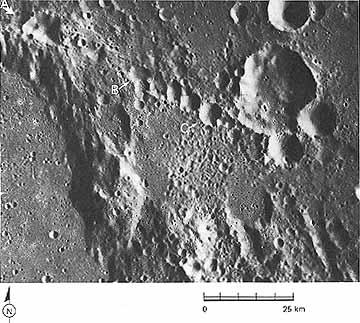
Chapter 5: Craters (3/6)
|
|
[128] FIGURE 124 [left].-This photo taken at low Sun angle emphasizes how common secondary impact craters are on the Moon. The primary craters whose ejecta formed most of the secondaries in this part of southeastern Mare Imbrium can be identified by observing the orientation of the secondary crater chains and of the "herringbone" ridges that splay outward from individual secondary craters. The chains are radial to the primary or parent crater and the apexes of the "herringbone" ridges point toward it. The most conspicuous chain and the chain at the left center of the picture are secondary to Eratosthenes, 250 km to the southeast in the direction of the arrows labeled E. Lying athwart these chains is a large younger cluster (arrow C) secondary to Copernicus, 400 km to the southwest. The chains in the extreme upper right corner (arrow T) are secondary to Timocharis whose rim is only 35 km northeast of the pictured area. Most of the other, smaller chains, clusters, and "bird's-foot" gouges can also be traced to Eratosthenes, Copernicus, or Timocharis, but some probably were created by fragments from more distant sources. The largest crater in the scene is Timocharis A, 8 km in diameter.-D.E.W.
|
FIGURE 125 [below].-This oblique view across southern Mare Imbrium looks toward Copernicus, the large crater near the horizon. The distance from the lower edge of the picture to the center of Copernicus is 400 km. The mountains at the edge of Mare Imbrium are the Montes Carpatus, and the large crater near the center of the picture is Pytheas, almost 19 km in diameter. Copernicus is one of the youngest of the Moon's large craters. It is visible from Earth, even without the aid of a telescope because of its bright ejecta blanket and its extensive bright rays. The many chains and clusters of small irregular craters and the many bright streaks or rays extending across Mare Imbrium are caused by the secondary impact of debris ejected from Copernicus. The viewing angle accentuates the radial pattern of the secondary impact features. The Sun angle is sufficiently low to show their relief, but high enough to show the contrast between the bright streaks and the normal dark mare surface. As in figure 124, herringbone ridges point toward the primary crater, and the flaring sides of the secondary craters point away from it. The arrow midway between Copernicus and the left edge of the photograph points to a less common pattern of secondary craters; these are concentric to Copernicus.-M.C.M.
|
[129] |
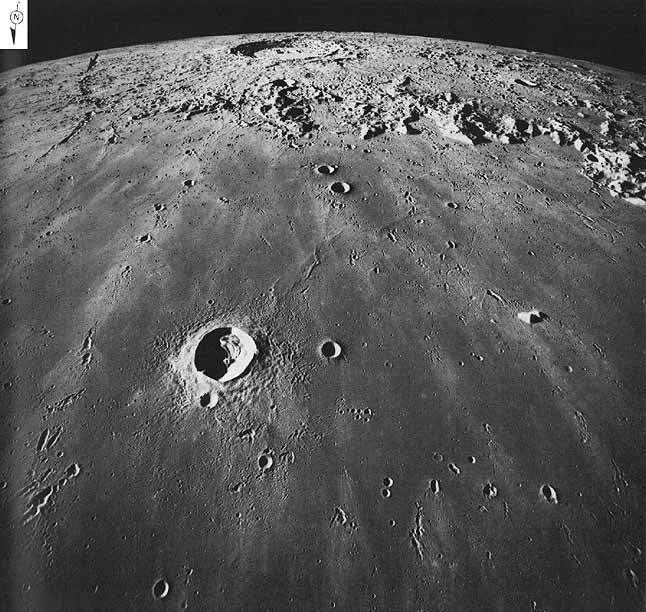 |
|
[130] FIGURE 126 [right].-Here is another area in southern Mare Imbrium that shows a profusion of bright rays and chains of secondary craters from Copernicus, which is located about 380 km southeast of the center of the picture. The large crater near the left (west) side is Euler. (See figs. 64 and 137 to 139.) Here lighting conditions are ideal for showing how the material ejected from Copernicus secondaries is splashed downrange (away from Copernicus) to form the herringbone ridges and the bright patches or streaks. Individual craters and their associated ridges sometimes combine to form a pattern that resembles the imprint of a bird's foot. The area within the small rectangle is shown in much more detail in figure 127.-H.M.
|
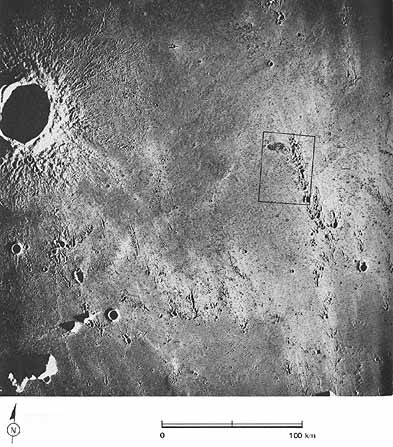 |
|
| |
|
|
FIGURE 127 [left].-A secondary Copernicus crater chain is enlarged in this view. (See fig. 126.) Its elongate shape, the irregular form of the individual craters, and the splashed appearance of their ejecta are clearly discernible. Also present in this view are two or three groups of craters (arrows) that are also of secondary impact origin, but are different from the Copernicus chain. They occur in clusters, not chains. The craters within the clusters are smaller and more regular in shape and do not have the splashed appearance of the Copernicus secondaries. At arrow 2, some of them are superposed on-and hence are younger than-the Copernicus chain. A few have faint herringbone ridges that veer toward the west, indicating that the primary crater lies in that direction. Except for the familiar crater Aristarchus (fig. 165), which is 580 km west of this area, there are no other large craters that are also young enough to have been the cause of these secondaries. Aristarchus is, furthermore, younger than Copernicus. For these reasons Aristarchus crater is the most likely source of the material that landed here to form the clusters of craters.-G.W.C.
|
|
[131] FIGURE 128 [right].-These three clusters of secondary craters (see arrows) are on the east flank of the larger crater Ptolemaeus near the center of the Moon's near side. Each cluster has a ridged and hummocky appearance. The primary crater has not been identified in this case, but the configuration of the clusters tells us that it must be to the south of Ptolemaeus. Note that the south-facing side of each cluster is more sharply defined than the northfacing side. This is a consequence of the oblique trajectory of impacting fragments that causes the ejecta of the secondary craters to be propelled away (down range) from the primary crater. Observations of manmade impact craters have shown that the individual fragments within a cluster of secondary debris strike the surface nearly simultaneously. In the process, ejecta from one secondary collides and interferes with ejecta from adjacent craters, producing a ridged and hummocky surface.-H.J.M.
|
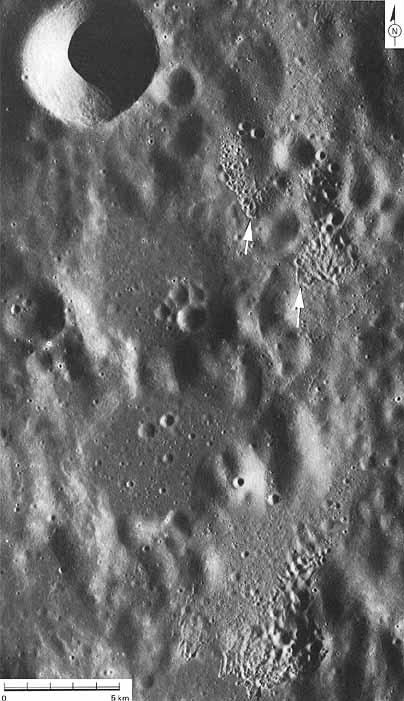 |
|
[132] FIGURE 129 [right].-The secondary crater cluster near the lower edge of figure 128 is enlarged to show more detail. The largest crater within the cluster is about 600 m wide. The small, sharp, circular craters are primary craters that postdate the cluster. Some poorly defined V-shaped ridges at the south edge of the cluster point southward toward the primary crater. The effects of the secondary cratering are much more extensive than was apparent in the smaller scale picture. The finely lineated terrain west and north of the cluster is caused by a great many parallel and subparallel ridges, gouges, grooves, and barely visible small irregular craters. They are apparently caused by the impact and deposition of material ejected from the secondary craters. Craters formed during this stage are tertiary craters but are rarely distinct enough to be recognized. Several possible examples are indicated by arrows.-H.J.M. |
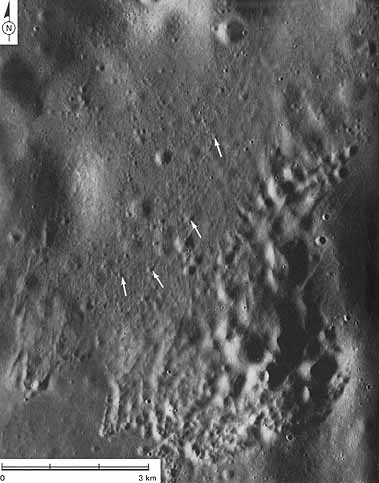 |
FIGURE 130 [below].-The Davy crater chain (arrow) is one of the most spectacular chains of craters on the Moon. It extends for about 50 km across the floor of the large, very old crater Davy Y (Y) and onto its eastern rim. The chain may be related in origin to the pair of irregular craters Davy G (G) and Davy GA (GA), 75 km from the furthest end of the chain. Two origins have been proposed. Some lunar geologists believe it is a chain of secondary impact craters, and others believe it is a line of volcanic craters. The simple geometry of the Davy chain, the symmetry and uniform spacing of its individual craters, and its alinement with Davy G strongly support, in this writer's opinion, a volcanic origin. Also arguing against a secondary impact origin is the fact that the Davy chain is a lone feature. There are no other similar chains with this trend in the area. As was shown earlier in this chapter (figs. 124 and 125), secondary crater chains tend to occur in large numbers within the belt of secondary craters surrounding a large primary crater.
On Earth some rocks from deep within the crust have been brought to the surface through volcanic orifices, thus providing a means of studying material that would otherwise be inaccessible. For this reason the Davy area was once seriously considered as a landing site. However, when the originally planned number of Apollo missions was reduced, the Davy area was one of those eliminated.-H.M.
|
[133] |
 |
|
[134] |
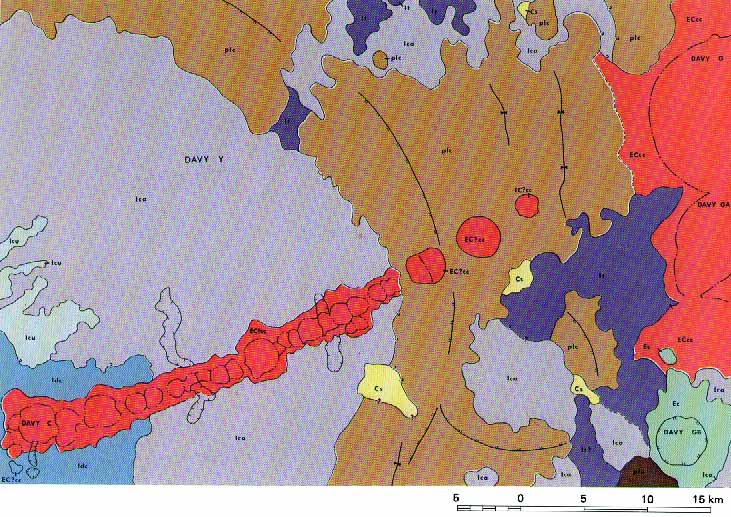 |
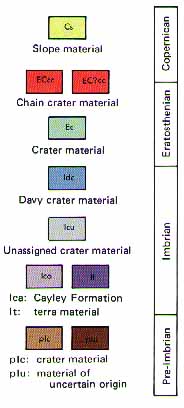 |
|
FIGURE 131 [above].-This is a reduced version of part of a geologic map of the Davy area compiled by R. Hereford of the U.S. Geological Survey. Photogeologic mapping did not provide an unambiguous answer to the question of the origin of the Davy chain, but did provide much information on the succession of events that shaped this part of the Moon's surface. Following the map explanation, the succession is briefly as follows: (1) An early period of intense cratering during which the large crater Davy Y was excavated and its rim uplifted. (2) A presumably brief period during which the Cayley Formation and one other plains unit were deposited. (The origin of the Cayley as a semifluid cloud of ejecta from the Imbrium basin was discussed in figs. 46, 54, and 55.) (3) A long period when scattered medium-sized craters and their deposits were formed. (4) The formation of the Davy crater chain and the larger, presumably volcanic, craters Davy G and Davy GA. (5) Finally, mass movement of material on steep slopes to form relatively fresh slope deposits and sporadic impact by very small bodies that made craters too small to be shown at the scale of the map.-G.W.C.
|
|
| ||
|
| ||
|
| ||
|
| ||
|
| ||
|
| ||
|
| ||
|
| ||
|
|
|
[135] FIGURE 132 [right].-The crater chain extending from the large arrow at A is part of a discontinuous lineament that grazes the northeast rim of Ptolemaeus (left), and that may extend as far as 720 km beyond the edge of the picture. The origin of the chain is perplexing. In some respects it resembles Imbrium sculpture (figs. 36, 47, 48, and 53), except that the individual craters in the chain are more circular and more distinct. An apparent difference in freshness of craters within the chain (as at B and C) suggests that the chain may have formed by volcanism localized along a tectonic fracture. On the other hand, the lack of visible faulting in this area and the strong resemblance of this chain to some secondary crater chains suggest the more likely alternative that it originated by secondary impact, perhaps by ejecta from Schrodinger, a relatively small double-ringed basin in the south polar region.-C.A.H. |
|
|
| |
|
|
FIGURE 133 [right].-This photograph shows the crater chain of figure 132 in its regional context (large arrows). Trending east-southeast, the chain sharply transects the Imbrium sculpture, which trends south-southeast (smaller arrows near margins). The difference in trends argues strongly against a common origin and somewhat less strongly against a related origin. The laser altimeter on board the Apollo 16 CSM showed that the area directly east of Ptolemaeus was one of the highest areas on the near side of the Moon along the ground track. The other anomalously high area was in the vicinity of the Apollo 16 landing site near Descartes. Also in the Ptolemaeus area the Apollo 16 mass spectrometer recorded an excepionally high ratio of aluminum to silicon. The relationship between high elevation and high aluminum content and the presence of a prominent crater chain are probably more than coincidental. One interpretation is that volcanism in this part of the highlands extended into a later period of time than in most other highland areas on the near side and that more differentiated materials were extruded. The crater chain may be related in origin to this late-stage eruption.-H.M.
|
|
[136] |
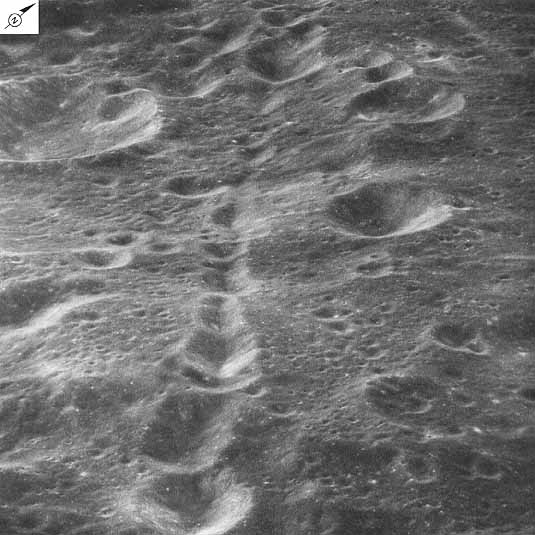 |
FIGURE 134 [above].-This oblique view taken with the Hasselblad camera shows a crater chain on the far side, about 500 km north of Tsiolkovsky. For an idea of the scale, the large crater near the upper left corner is about 26 km wide. The origin of this chain is controversial. To some geologists, the irregular shape of many of the craters suggests that the chain was formed by the impact of a stream of ejecta from a large primary crater. The presence of herringbone ridges would have strengthened this interpretation, but none are visible; perhaps the high Sun angle and the oblique viewing angle of this scene have obscured them. To others the simple geometry of the chain suggests a volcanic origin. However, there is an apparent lack of faulting to control the alinement of the craters and an apparent absence of a blanket of volcanic ejecta. The origin of this chain may not be decipherable until, and unless, additional photography becomes available.-G.W.C.
[137] FIGURE 135 [below].- This crater chain in southern Mare Serenitatis is clearly of internal origin because it is lined up parallel to several fault valleys or grabens. The craters in the chain do not appear to have any rims; consequently, they may have formed by collapse and not by the explosive ejection of volcanic material. The large crater in the right side of this scene, however, has a rim and so cannot be the result of collapse alone. The finely lineated texture across the left side of the photograph is caused by ejecta from the crater Dawes to the south. - H.A.H.

|
[138] FIGURE 136 [right].-Linear features of external and internal origin are contrasted in this area of southernmost Mare Tranquillitatis. The northtrending line of overlapping, very irregular craters along the east edge of the picture is clearly a chain of secondary impact craters. Its trend is radial to Theophilus, a large crater of early Copernican age that lies about 105 km south of this area. The flaring shapes of some of the craters and their state of preservation also suggest that Theophilus is the primary crater. The narrow, straight rifle or graben that extends westward across the picture is clearly of internal origin. It formed when tensional forces ruptured the crust, causing the floor of the rifle to subside along faults. As is discussed in chapter 6, straight rifles are commonly the sites of volcanic cones or of blankets of volcanic ejecta; however, there are no signs of volcanism here that can be related to this rifle.-M.J.G. |
 |
|
[139] FIGURE 137 [right].-Parts of three frames from the Apollo 17 panoramic camera were mosaicked to form this high- resolution view. The crater Euler in southwestern Mare Imbrium is an exceptionally fine example of a young mediumsized crater. Twenty-seven km in diameter, Euler has most of the features that typify young craters in this size range. Its sharp rim shows little evidence of rounding. A solid blanket of ejecta is visible for approximately one- half crater diameter outside the rim, and the radial pattern of secondary craters, crater clusters, ridges, and grooves is visible outward to a full crater diameter. Terraces formed by slumping of the steep crater walls, probably contemporaneously with the formation of the crater, are clearly evident. The steepness of the walls and the fact that the crater floor is below the level of the surrounding mare surface indicate that relatively little erosion and infilling have occurred. Other features typical of medium-sized craters are the central peak and the level floor surrounding the central peak. The pattern of ejecta around Euler is notably asymmetric because the area was later flooded by mare lavas that inundated parts of the ejecta blanket and other ejecta features.-M.C.M. |
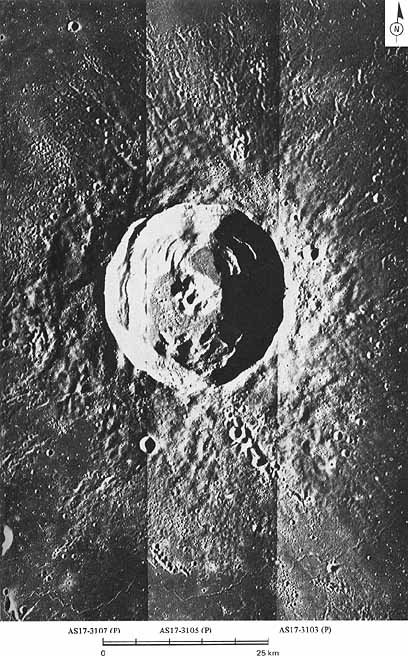 |
| Next |


